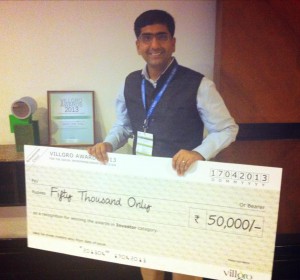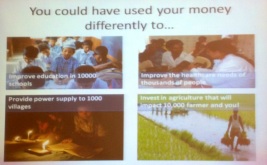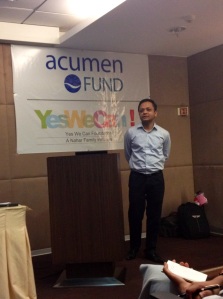On day two of the Ashoka India Future Forum, Fellows had the chance to sit back and relax, while for once the pressure was off of them. It was time for the Reverse Pitch where investors pitched social entrepreneurs. A panel of fund investors and philanthropists each had three minutes to pitch their investment strategies, why they would be a great partner, and why to take their money amongst others.
Karuna Jain from Acumen pitched first. Acumen was a pioneer of impact investing in 2001 when they set out to treat the poor as consumers of goods and services instead of receivers of charity, giving them the dignity of choice. Karuna pitched that even though Acumen’s investments are for-profit, they are more patient, risky, and socially-focused than traditional equity investors, because their funding comes from philanthropic donors. Apart from financial capital, Acumen also serves on boards, provides advisory support with growth strategies and fundraising, offers a global fellow program, and guarantees debt support from US AID. They are currently invested in Ashoka Fellows Umesh from Hippocampus, Vijay Mahajan BASIX, and Sam Goldman from d.Light Solar.
As the most traditional investor on the panel, Kushal Agrawal from Aspada Investment Advisors pitched second. Aspada manages a $17M fund supported by Soros, Omidyar Network, and Google with four portfolio companies, and they launched a second $10M fund six months ago, which recently made its first investment into an agricultural supply chain company. Aspada invests in essential services with an aim to improve livelihoods, and they measure their impact by looking at how many people benefit from their investments. To date they have found the average income of their beneficiaries is 10,000 to 12,000 rupees per month. “It may not serve the poorest of the poor, but it creates infrastructure where there is none before,” said Kushal.
Representing the Omidyar Network, C.V. Madhukar brought a unique pitching perspective. Before wearing an investor hat, he was an Ashoka Fellow for his work on increasing public engagement in lawmaking. Omidyar makes both equity and grant investments in initiatives creating social impact in financial inclusion, education and governance, and they believe technology is a huge lever for change. Their approach is not just of investing, but of engaging and supporting the entrepreneur in ways that meaningful add value. Omidyar has worked with Ashoka Fellow Shaheen Mistra from Teach for India.
Pranav Nahar from Grassroots Business Fund turned the tables again, giving a reverse-reverse pitch of why you should not take his money or investments from any other impact investor. He shared “the heartbreaking story” that even though GBF is mission-aligned with social entrepreneurs, their capital is expensive, they only invest in for-profit businesses that can scale up commercially, and their process can be bureaucratic and slow. He pitched that for any social entrepreneur the most important factor to consider when taking investment is whether your values align. “If you get the wrong money, it will be a thorn in your foot for a long time,” he said.
The final two panelists represented philanthropic investors. Vidya Shah pitched from EdelGive, a CSR initiative of Edelweiss founded to bring skills and expertise from the for-profit to non-profit sector. EdelGive hopes to help organizations become stronger and effective, while also embedding a culture of philanthropy and employee engagement within Edelweiss. Vidya pitched that EdelGive is a partner, not just a donor. “We remain involved in organizations, not just in monitoring and reporting, but in building capacity in the organizations we fund,” she said. Edelweiss employees also give long-term support on a pro-bono basis.
Lastly, Ajit Kanitkar from Ford Foundation gave his staircase pitch, joking that he grew up at a time without elevators. Ford Foundation prides itself on the legacy of innovation. “We need to break new ground,” he said. “We feel fortunate to support individuals and ideas, which may fail.” They make risky investments that push the envelope forward and exit once a sector or field has enough resources and mainstream investor interest. They used to invest in microfinance, but exited once there was sufficient outside interest, now they are looking at livelihoods.
The Q&A was lively with an interesting combination of questions about return on investment, the burden of impact measurement, openness about failure, geographic focus area, and the role of creative arts as a social impact tool.
“The old age of capitalism where funders are hiding a bag of money is over,” said Vishnu from Ashoka to wrap up the session. “There is a much more collective effort underway.” Investors are now looking to foster a spirit of transparency, feedback, and inclusiveness.
I originally wrote this article for the Ashoka India blog for the India Future Forum.






